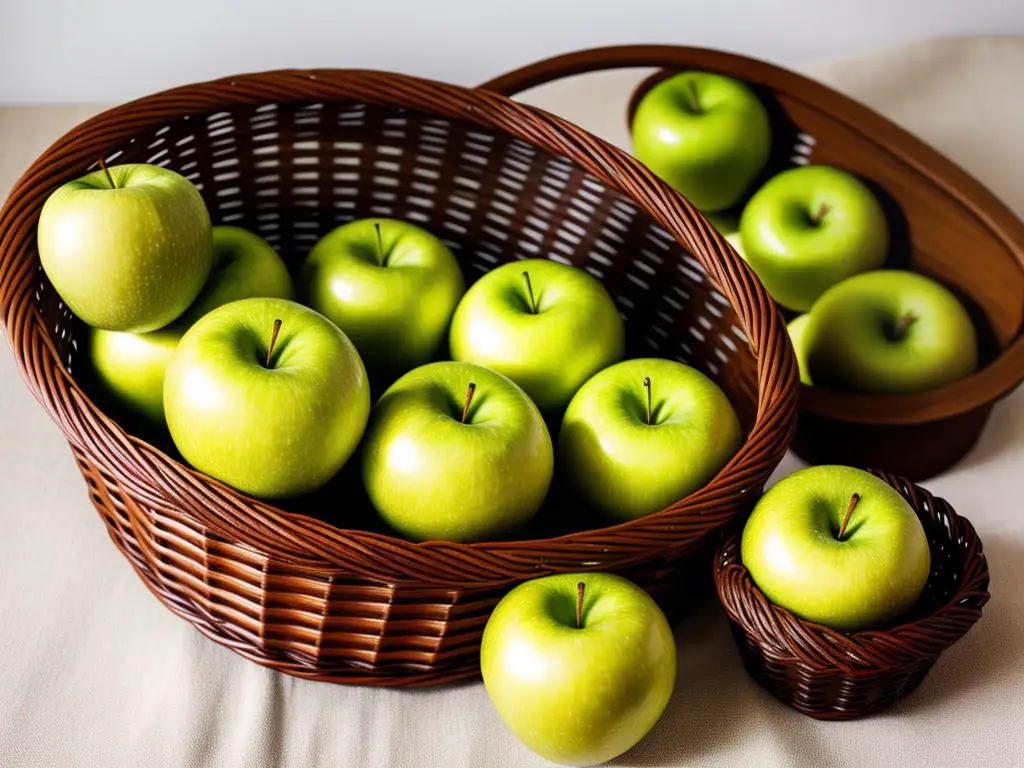When you think of green apples, a burst of crisp tartness might be the first thing that comes to mind. That’s not always the case, however, as the world of green apples encompasses a sweet spectrum beyond the familiar Granny Smith. From their international varieties and origins to the intriguing science of their taste, the story of green apples is as diverse as their flavors. Indeed, these vibrant fruits carry a sweet profile that has not only charmed taste buds across cultures but also contributed significantly to health benefits and culinary delight. This exploration dives into the multifaceted nature of green apples, offering an insightful journey into their sweetness.
Green Apples: Variety and Origins
Variety and Origin of Green Apples
There is a wide variety of green apples, with most of them originating in North America amidst the 17th century. The Granny Smith apple is one of the most well-known green apple varieties across the globe. The discovery history of the Granny Smith apple takes us back to Australia in the mid-19th century when Maria Ann Smith (hence the apple’s name) found an apple sapling growing by a creek on her property. Intrigued by the apple’s taste and properties, she propagated from the tree, which led to the worldwide cultivation of Granny Smith apples.
The Golden Delicious apple, although commonly identified by its bright, yellow to greenish color, originates from West Virginia in the U.S. This apple possesses a mild, sweet-tasting flavor that differentiates from the tart flavor associated with most green apples.
Another variant from America, Rhode Island Greening, has been a classic dessert apple since the 17th century in colonial America. This apple has a tart and savory taste, making it perfect for apple sauce and cider.
Taste of Green Apples
While the color of an apple doesn’t necessarily equate to sweetness or tartness, green apples tend to have a stronger, slightly sour taste compared to their red and yellow counterparts, which are known for being sweeter.
The Granny Smiths are known for their sharp, tangy flavor. This apple type is high in acidity resulting in a more potent sharpness that quickly hits your taste buds, offering a refreshing tartness rather than sweetness. This tartness makes Granny Smiths a popular ingredient for pies and salads, nicely counteracting the sweetness of other ingredients.
The Newtown Pippin, another variety of the green apple originating from Newtown (now known as Elmhurst, New York), presents a rare balance of sweet and sharp tastes. This juicy apple provides an extended, wine-like finish making this a preferred choice for apple cider and premium apple-based distilled spirits.
Golden Delicious, unlike other green apples, offers a sweet flavor, due to its low acid and high sugar content. These apples have a thin skin, and their flesh remains crisp. They are often preferred for fresh eating, apple butter, or other preserves.
Debunking the Color-Sweetness Myth
The common assumption that the color of an apple dictates its sweetness is a prevalent misconception. In reality, factors such as sugar content and the specific apple variety play a more significant role in determining the sweetness of the fruit. For instance, the Golden Delicious apple possesses a sweet flavor, despite its green color, illustrating that sweetness is not exclusively determined by red tones.

The Science of Taste: Understanding Sweetness in Green Apples
An In-Depth Look at Green Apples
Contrary to popular belief, green apples, or Malus domestica, are not simply immature red apples. They are a distinct apple variety in and of themselves. Recognized subtypes of green apples include Granny Smith, Golden Delicious, and Pippin, each with individually unique taste profiles. These subtypes vary in sweetness and tartness, further debunking any color-related assumptions about apple taste.
Sugar Content and Sweetness
The sweetness of any apple, green included, is determined by its sugar content. The sugar in fruits, including apples, is primarily fructose. This sugar is what gives apples their sweetness. Fruit sugars provide calories for humans and other animals, which is why they are an integral part of many diets. However, green apples typically have less sugar than red apples, which often results in a more tart flavor.
Factors Affecting Apple Sweetness
Yet, the sugar content is not the only element that influences the sweetness of an apple. Other factors include genetic makeup, climate, and maturity of the apple. Each variety of apple has its unique genes that dictate its sweetness, tartness, and other taste attributes. The climate where the apple is grown plays a considerable role as well. Apples that are grown in warmer climates tend to contain more sugar and thus are sweeter than those grown in colder conditions.
Importance of Apple Maturity
As for the maturity of the apple, apples continue to produce and store sugar as they ripen. This means that a ripe green apple, such as a fully mature Granny Smith, will be considerably sweeter than an immature one. However, even at the peak of their maturity, green apples maintain their characteristically tart edge.
The Role of Acidity in Green Apple Sweetness
It should also be noted that the perceived sweetness of an apple can also be influenced by its acidity level. Acidic flavors have a sharpening effect on our taste buds which can enhance our perception of sweetness. Green apples have higher acidity levels compared to red apples, which contributes to the sour-bitter taste that complements their natural sweetness.
A Comparative Analysis on Green Apple’s Sweetness
Green apples, universally recognized as Granny Smith apples, carry a distinct trait of being tart along with a hint of sweetness, although it might not be as sugary as the red or other apple varieties. They are typically identified by their bright green skin. Moreover, an important aspect to highlight is that, despite their tanginess, these green apples offer a substantial variety of essential nutrients, thereby rendering numerous beneficial health effects.

Nutritional Profile and Health Benefits
Sweetness of Green Apples
To delve deeper into their sweetness, green apples indeed have a sweet attribute in them, but the level of sweetness drastically depends on various elements. It is reliant on the variety of apple, the kind of climate they were grown in, and their level of ripeness during consumption. Hence, in conclusion, it’s undeniable that green apples can be sweet, but referring to ‘sweetness’ in the context of green apples is a relative term.
Nutritional Profile of Green Apples
Green apples are a low-calorie food, with a medium-sized apple containing about 95 calories. They are also rich in dietary fiber, providing around 4 grams per serving. This fiber comes in the form of both soluble and insoluble fiber, which play key roles in promoting digestion, reducing cholesterol levels, and maintaining blood sugar control. The tart-sweet taste of green apples is attributed to the balance between its natural sugar content and the malic acid present within it.
Health Benefits of Green Apples
The sweetness in green apples contributes to their various health benefits apart from just making them a delightful snack. The dietary fiber found in them aids in digestion by adding bulk to the stool, which helps prevent constipation and promotes regular bowel movements. Additionally, the pectin, a type of soluble fiber found in apples, can help lower bad cholesterol levels.
The antioxidants present in green apples, including Vitamin C and flavonoids, are beneficial for skin health. They fight against skin damaging free radicals and prevent premature aging. Some people even use green apple juice topically to help improve skin texture and appearance.
Green apples also contribute to heart health. The fiber, potassium, and Vitamin C present within them work synergistically to maintain normal heart rhythm, lower blood pressure, and reduce risk of stroke. Furthermore, research suggests that apples have compounds called polyphenols which have been linked to lower risk of heart disease.
Eating green apples can also have a positive impact on blood sugar regulation, making it a healthy choice for people with diabetes. The fiber in apples slows down the digestion of sugars and carbohydrates, preventing spikes in blood sugar level.
In Conclusion: Green Apples and Their Unique Flavor
Green apples may not have the overt sweetness commonly associated with certain other apple varieties, yet they offer a distinct, unique taste and abundant nutritional benefits that make them a valuable and appealing dietary choice.

Green Apples in Culinary: Sweet Recipes
Understanding the Unique Balance of Granny Smith Apples
The Granny Smith, a type of green apple identified by its vibrant green color, is distinguished by its tart and tangy flavor. Despite this tanginess often overshadowing their sweet taste, it’s worth noting that green apples are indeed still sweet, as they contain significant amounts of natural sugars. However, this sweetness is subtly blended with their tangy character, making it less pronounced when compared to notably sweet red varieties like Honeycrisp and Gala.
The Culinary Appeal of Green Apples
In the culinary world, green apples are often praised for their more nuanced, balanced flavor profile. Their unique blend of tartness and sweetness makes them a great addition to various sweet recipes. They can cut through the richness in heavier dishes, lending a balance of flavors, while their sweet-tart identity can bring an added layer of complexity to simple dishes.
Highlighting Sweetness in Green Apple Recipes
One popular example of a sweet recipe that highlights the sweetness of green apples is apple pie. The tart green apples pair perfectly with the sweetness of the sugar and spices in the filling, enhancing the overall flavor. Green apples can also be used in making apple tarts, crisps, crumbles, and even candy apples. Apart from baked goods, green apples can be a part of sweet salads, paired with nuts, and berries, and dressed with a sweet vinaigrette to balance out the overall sweet-and-tart flavor.
Choosing the Perfect Green Apples for Sweet Dishes
When choosing green apples for sweet dishes, always look for firm and shiny apples, and avoid those with bruises or brown spots. The apples should feel heavy and solid in your hand. The size of the apple may also affect the flavor, with smaller apples tending to be sweeter than larger ones.
Managing Tartness in Green Apple Desserts
While preparing desserts with green apples, remember that the tartness of the apple tends to intensify when it’s cooked. Therefore, it’s always a good practice to taste as you go and adjust the sugar levels according to the sweetness of the apples.
Green Apples: A Unique Sweet and Tart Delight
Despite not being the sweetest among the apple varieties, green apples bring a uniquely balanced sweet flavor to various dishes that can’t be replicated by any other apple varieties. With the right recipes, green apples can not only just be a part of sweet dishes, they can also shine as the star, highlighting their distinct sweet and tart flavors.

So, the next time you bite into a green apple, remember that you’re experiencing more than just a simple fruit. You’re tasting the combined result of careful cultivation, certain apple varieties, and thoughtful harvesting. Alongside it, you’re appreciating a nutritious snack offering a wealth of health benefits. Finally yet importantly, the sweet delight of green apples also stands as a beloved ingredient in many of our cherished recipes, enhancing our culinary experiences with their distinct flavors. The intrigue of green apples extends beyond their vibrant exterior, reaching into their sweet core, a testament to their global appeal and the sheer variety offered by Mother Nature.
